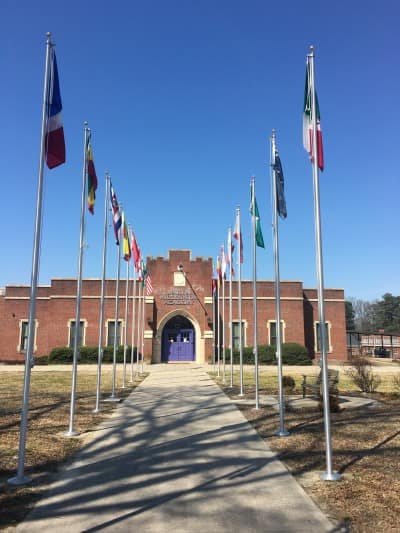
As you walk up the sidewalk to the doors of Martin Millennium Academy in Tarboro, flags of countries from around the world flap in the wind.

Mexico.
Ecuador.
The United States.
You would be forgiven if you are temporarily confused and forced to remind yourself that you are not at an elite prep academy in the wine country of Virginia or rural Massachusetts. The disconnect between your perception of the school upon approach and what you think a rural school should look like is exactly the point for Principal Erin Swanson and Edgecombe County Public Schools Superintendent John Farrelly.
Edgecombe County’s 56,552 residents reside an hour and ten minutes, give or take a few speed traps, from Raleigh, and in many ways it feels a world away. The median income is $31,615 and 38.1 percent of children live below the poverty line.
A few years ago, you would not have found the global feel upon the approach to Martin Millennium. Superintendent Farrelly referred to the old Martin Middle as a “school on fire” with “horrific” rates of student achievement.
The lack of results by Martin Middle, and other schools in the area, had created a desire for change. Enter North East Carolina Preparatory School, a charter school, which the superintendent says played a role in 1,000 students withdrawing from the traditional public system.
Farrelly became the Superintendent of Edgecombe County Public Schools in the summer of 2012 facing a host of challenges, including the withdrawal of nearly one out of every six students from the school system, which had impacts on funding, morale, and direction.
Farrelly, and others in leadership, understood intuitively that they would need to be innovative in the face of challenges. Among other tactics, Farrelly turned to the Visiting International Faculty system to explore the concept of instituting a Global Schools model where global competencies come first. He had heard that a program in Fayetteville had shown tremendous progress, so he loaded ten buses up with educators, community leaders, and other staff to visit the program.
The goal of the global schools model is to challenge learners, increase exposure to diversity and different models of learning and thinking, and drive curiosity. Farrelly and his team explored STEM models, the concept of school wide themes, and more before deciding that the global schools model was the way to go.
And Martin Millennium would be the test case. The turnaround for Martin Millennium required new leadership in the form of Principal Erin Swanson, fourteen Visiting International Faculty who bring international perspectives and approaches, a new coat of paint, and changing the school into a K-8 school from its original middle school design.
The turnaround of Martin Millennium also meant fully embracing the global schools model, which includes the ability to sign students up for first come, first serve immersion classes where a foreign language is the lead language for the classroom.
Farrelly is working to turnaround the entire district. One of the more fascinating insights he shared as we all sat around a table in Principal Erin Swanson’s office was his idea of planting a flag in the ground one school at a time in an attempt to eventually “restore confidence in the entire school system.”
Farrelly went on say, “Every child in Edgecombe County deserves a global education, but we wanted to begin the pathway here at Martin Millennium.”
It is too early in the district-wide story to be certain about the long term impacts, but one statistic that Farrelly is proud of in these early days is that nearly 300 students have returned to Edgecombe County Schools after departing for charters.
The crux of Farrelly’s turnaround strategy is people. People matter. He says, “The development of leadership and an emphasis on innovation will set the standard.”
The success of the work may well depend upon the renewed emphasis on character, leadership, and mental well-being. But, of course, it also depends on every person in the community — including the families.
Principal Swanson led us on a tour of the school, underscoring the energy and excitement around the change. As we walked into each classroom, a student would hop up, hurry over, and greet us in the language of the class, which meant that a kindergarten student spoke to me in conversational Spanish even after I addressed them in English. When I peered over the shoulder of students writing in kindergarten and first grade, I was pleased to see well-written Spanish sentences.

And it wasn’t just the students who gave off energy, it was the teaching staff as well. One educator told us that she had stopped by her bank recently for a routine business transaction and her banker asked if she worked at Martin Millennium, when she confirmed that she did, her banker told her to keep up the good work.
And another educator that we spoke with might have summed it up best when she said, “Just riding by the school now is enough to give you pride.”
Turnarounds take time, but energy, optimism, innovative techniques, and pride are all good places to start.



